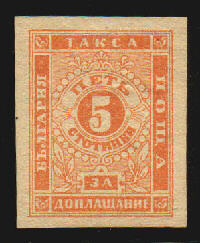
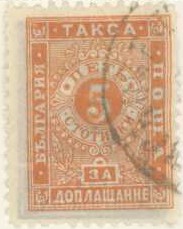
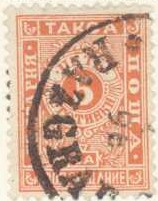
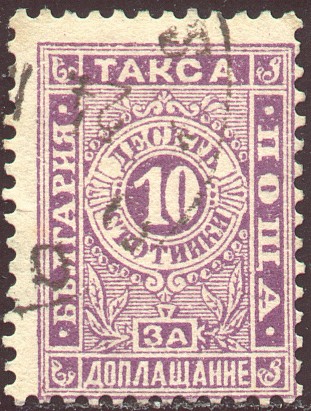
Return To Catalogue - Bulgaria
Note: on my website many of the
pictures can not be seen! They are of course present in the cd's;
contact me if you want to purchase them: evert@klaseboer.com.
5 s orange 10 s violet (only perforated) 25 s red 30 s green (only perforated) 50 s blue Surcharged
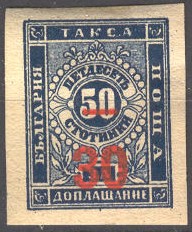
'30' on 50 s blue (perforated) '30' on 50 s blue (imperforated)
For the specialist: In 1884 the values 5 s, 25 s and 50 s were issued with a very peculiar perforation (so-called serpentine perforation):
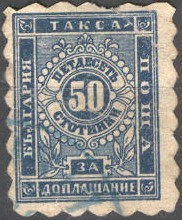
(Serpentine perforation)
The same 3 values were issued imperforate in 1886. From 1887 to 1896 normally perforated stamps were issued of all values.
Value of the stamps |
|||
vc = very common c = common * = not so common ** = uncommon |
*** = very uncommon R = rare RR = very rare RRR = extremely rare |
||
| Value | Unused | Used | Remarks |
| Serpentine perforation (1884) | |||
| 5 s | RR | R | |
| 25 s | R | R | |
| 50 s | R | R | |
| Imperforate (1886) | |||
| 5 s | *** | *** | |
| 25 s | *** | *** | |
| 50 s | *** | *** | |
| 30 on 50 s | *** | *** | |
| Wide perforation (about 11, 1887) | |||
| 5 s | *** | * | Two types; with small or large inscription on top and bottom |
| 25 s | *** | * | |
| 50 s | *** | *** | |
| 30 on 50 s | *** | *** | |
| Narrow perforation (13, 1896) | |||
| 5 s | *** | * | '5' smaller |
| 10 s | *** | * | |
| 30 s | *** | * | |
5 s red 10 s green 20 s blue 30 s lilac 50 s orange
These stamps have perforation 11 1/2.
Value of the stamps |
|||
vc = very common c = common * = not so common ** = uncommon |
*** = very uncommon R = rare RR = very rare RRR = extremely rare |
||
| Value | Unused | Used | Remarks |
| 5 s | c | c | |
| 10 s | * | c | Error: 10 s blue: RRR |
| 20 s | * | * | |
| 30 s | * | * | |
| 50 s | R | R | |
5 s green 10 s violet 20 s red 20 s orange 30 s orange 50 s blue 1 L green 2 L red 3 L yellow
These stamps have perforation 11 1/2. Specialists distinguish stamps issued on yellowish and white paper. The values 50 s , 1 L, 2 L and 3 L were used as postage stamps in 1923 and 1924.
Value of the stamps |
|||
vc = very common c = common * = not so common ** = uncommon |
*** = very uncommon R = rare RR = very rare RRR = extremely rare |
||
| Value | Unused | Used | Remarks |
| 5 s | c | c | |
| 10 s | c | c | |
| 20 s red | * | * | |
| 20 s orange | * | * | |
| 30 s | c | c | |
| 50 s | * | c | |
| 1 L | * | c | |
| 2 L | * | c | |
| 3 L | * | * | |
Surcharged, used as provisional postage stamps (1924)
10 s on 20 s orange 20 s on 5 s green 20 s on 10 s violet 20 s on 30 s orange
These stamps were issued in 1924. The following values exist: 1 L (black on green, brown, orange, red or violet on red) and in a different design: 2 L (green or violet) and 5 L (blue or red).
1 L brown and green 1 L green and yellow (1931) 1 L red and brown (1933)
1 L brown and red 1 L green and blue 5 L brown and blue (slightly different design)

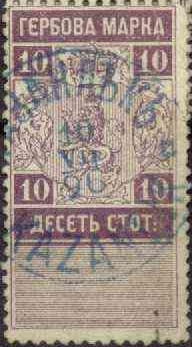
(Left: fiscal stamp with value in Cents, right: fiscal stamp with
value in Stotinki)
Note the resemblance with the fiscal stamps of Russia (the fiscal stamps were first printed in Russia).
The first Bulgarian fiscal stamps in the above designs were issued in 1879, the value was in 'CAHT' (cents) or 'FPAH' (Franc); the following values were issued: 20 c blue, 25 c brown, 30 c orange, 40 c red, 50 c green, 80 c violet, 1 F yellow and black, 3 F green and black, 5 F blue and black, 10 F lilac and black, 20 F grey and black, 50 F orange and black and 100 F blue. In 1889 some values received a surcharge: 10 st on 25 c brown, 20 st on 80 c violet.
In 1883 the currency was changed to 'CTOTNHKN' (as for the postage stamps): 10 st grey, 15 st black, 20 st blue, 50 st green, 1 L orange, yellow and black. In 1889 the inscription on top was slightly reduced (Vienna printing): 10 st grey, 15 st black, 20 st blue, 30 st orange (1893), 50 st green, 1 L yellow and black.
Many more values were issued after 1894.